Italica
Italica (Spanish: Itálica) north of modern-day Santiponce, 9 km northwest of Seville in southern Spain, was an Italic settlement founded by the Roman general Scipio in the province of Hispania Baetica. It was the birthplace of Roman Emperors Trajan, Hadrian, [1] and Theodosius (possibly).[2] It flourished under the reign of Hadrian, becoming an elaborate urban centre and obtaining the high status of colonia. The modern town of Santiponce overlies the pre-Roman Iberian settlement and part of the well-preserved Roman city.
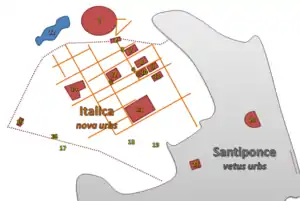
 The Roman amphitheatre of Italica seated 25,000 | |
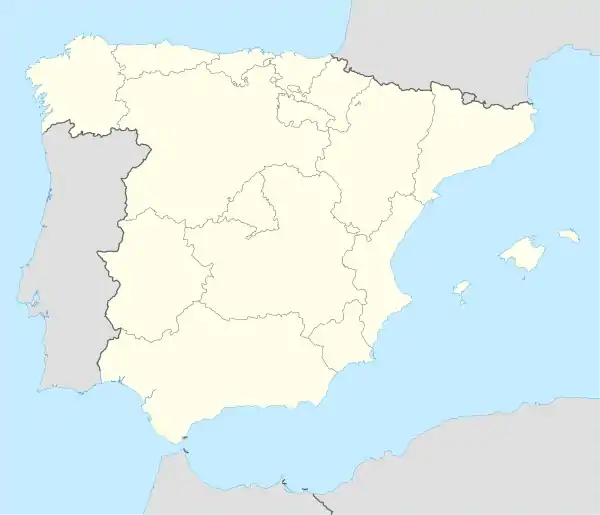 Shown within Spain | |
| Location | Province of Seville, Spain |
|---|---|
| Region | Hispania Baetica |
| Coordinates | 37°26′38″N 6°02′48″W |
| Type | Settlement |
| History | |
| Founded | 206 BC |
| Cultures | Roman |
| Site notes | |
| Condition | Ruins |
Roman history
...from this time, which was a little before the 144th Olympiad [206 BC], the Romans began to send prætors to Spain yearly to the conquered nations as governors or superintendents to keep the peace. Scipio left them a small force suitable for a peace establishment, and settled his sick and wounded soldiers in a town which he named Italica after Italy...
— Appian, Iberian Wars, Book VII, Chapter 38
Italica was the first Roman settlement in Spain and the first Roman city outside of Italy.[3] It was founded in 206 BC by Publius Cornelius Scipio during the Second Carthaginian War upon a native Iberian town of the Turdetani (dating back at least to the 4th c. BC) as a settlement for his Italic veterans, likely a majority of socii and a minority of Roman citizens, and named Italica after its inhabitants.[4] The nearby native and Roman city of Hispalis (Seville) was and would remain a larger city, but Italica's importance derived from its illustrious origin and from the fact that it was close enough to the Guadalquivir to control the area.[5]
As time progressed, Italica attracted new settlers from Italy and also grew with the sons of Roman soldiers and native women.[6] A branch of the Gens Ulpia from the Umbrian city of Tuder (the Ulpi Traiani) and a branch of the gens Aelia from the Picenian city of Atri (the Aelii Hadriani) were either among the original settlers of Italica or among the groups that later moved in the town (at any time between the third century BC and first century AD), as these tribes were the respective families of the Roman emperors Trajan and Hadrian who were born there.[7] This is the traditional viewpoint, held by a majority of historians such as Julian Bennet and Anthony R.Birley. On the other hand, the Spanish historian Alicia M. Canto has argued since 2003 that the Trahii, a family which is usually also thought to be Umbrian and that intermarried with the Ulpii, were the original paternal family of Trajan and a relevant local indigenous family rather than Italic immigrants.[8]
The vetus urbs (original or "old" city) developed into a prosperous city and was built on a Hippodamian street plan[9] [10] with public buildings and a forum at the centre, linked to a busy river port. Italica thrived especially under the patronage of Hadrian, like many other cities in the empire under his influence at this time, but it was especially favoured as his birthplace. He expanded the city northwards as the nova urbs (new city) and, upon its request, elevated it to the status of colonia as Colonia Aelia Augusta Italica even though Hadrian expressed his surprise as it already enjoyed the rights of "Municipium".[11] He also added temples, including the enormous and unique Traianeum in the centre of the city to venerate his predecessor and adopted father, and rebuilt public buildings.
The city started to dwindle as early as the 3rd century; a shift of the Guadalquivir River bed, probably due to siltation, a widespread problem in antiquity that followed removal of the forest cover, left Italica's river port high and dry whilst Hispalis continued to grow nearby.
The city may have been the birthplace of the emperor Theodosius I[12] and of his eldest son Arcadius (born in Spain in 377 A.D., during his father's exile).[13]
Italica was important enough in late Antiquity to have a bishop of its own, and had a garrison during the Visigothic age. The walls were restored by Leovigildo in 583 AD during his struggles against Hermenegildo.[14]
Rediscovery and excavations
In recent centuries, the ruins became the subject of visits, admiration and despair by many foreign travellers who wrote about and sometimes illustrated their impressions. Italica's prestige, history and fame were not enough, however, to save it from being the subject of continued looting, and a permanent quarry for materials from Ancient times to modern ones. In 1740 the city of Seville ordered demolition of the walls of the amphitheatre to build a dam on the Guadalquivir, and in 1796 the vetus urbs was used to build the new Camino Real of Extremadura. The first law of protection for the site took effect in 1810 under the Napoleonic occupation, reinstating its old name of Italica, and allocating an annual budget for regular excavation.
One of the first excavators was the British textile merchant and Seville resident Nathan Wetherell, who uncovered nearly 10 Roman inscriptions in the vicinity of Italica in the 1820s that were later donated to the British Museum.[15] [16] Regular excavation, however, did not materialise until 1839-1840.[17] By Royal Order of 1912 Italica was declared a National Monument, but it was not until 2001 that the archaeological site of Italica and the areas of protection were clearly defined.
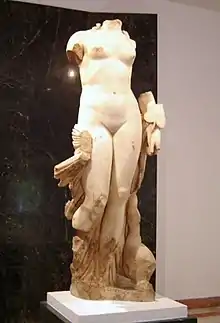
The site
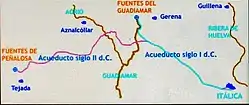
As no modern city covered many of Italica's buildings of the nova urbs, the result is an unusually well-preserved Roman city with cobbled Roman streets and mosaic floors still in situ. Many rich finds can also be seen in the Seville Archaeological Museum, with its famous marble statue of Trajan.[18]
The archaeological site of Italica encompasses mainly the nova urbs with its many fine buildings from the Hadrianic period. The original vetus urbs (old town) lies under the present town of Santiponce.
Extensive excavation and renovation of the site has been done recently and is continuing.
The small baths and the Theatre are some of the oldest visible remains, both built before Hadrian.
Italica’s amphitheatre was the third largest in the Roman Empire at the time, being slightly larger than the Tours Amphitheatre in France. It seated 25,000 spectators, about half as many as the Colosseum in Rome. The size is surprising given that the city's population at the time is estimated to have been only 8,000, and shows that the local elite demonstrated status that extended far beyond Italica itself through the games and theatrical performances they funded as magistrates and public officials.
From the same period is the elite quarter with several beautiful (and expensive) houses decorated with splendid mosaics visible today, particularly the:
- House of the Exedra
- House of the Neptune Mosaic
- House of the Birds Mosaic
- House of the Planetarium Mosaic
- House of Hylas
- House of the Rhodian Patio.
The Traianeum
The Traianeum was a large, imposing temple in honour of the Emperor Trajan, built by his adopted son and successor, Hadrian. It occupies a central double insula at the highest point of nova urbs. It measures 108 x 80 m and is surrounded by a large porticoed square with alternating rectangular and semicircular exedra around its exterior housing sculptures. The temple precinct was decorated with over a hundred columns of expensive Cipollino marble from Euboea, and various fountains.[19]
Aqueduct
The aqueduct[20] of 37 km total length was first built in the 1st c. AD and extended under Hadrian to add a more distant source for supplying the expanded city.[21] It fed a huge cistern at the edge of the city which remains intact.[22] Some of the piers of the arches are still visible near the city.
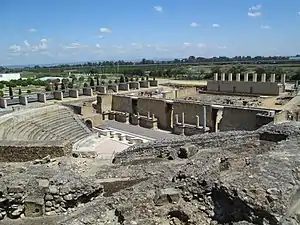 Theatre
Theatre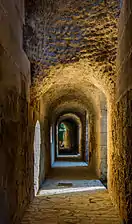 A vault in the amphitheatre
A vault in the amphitheatre Votive plaque with engraved feet at the entrance of the amphitheatre
Votive plaque with engraved feet at the entrance of the amphitheatre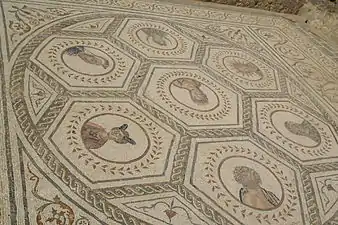 Mosaic floor in the House of the Planetarium
Mosaic floor in the House of the Planetarium Planetarium mosaic
Planetarium mosaic Neptune mosaic
Neptune mosaic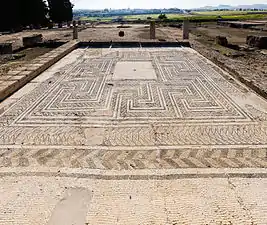 Isis temple mosaic
Isis temple mosaic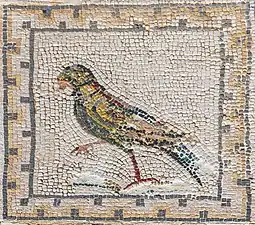 Mosaic floor in the House of the Birds
Mosaic floor in the House of the Birds
See also
References
- Alicia M. Canto, "Itálica, sedes natalis de Adriano. 31 textos históricos y argumentos para una secular polémica", Athenaeum. Studi di letteratura e Storia dell'Antichità 92.2, 2004, 367–408.
- Alicia M. Canto "Sobre el origen bético de Teodosio I el Grande, y su improbable nacimiento en Cauca de Gallaecia", Latomus. Revue d'Études Latines 65.2, 2006,388-421.
- Roman-Italic migration in Spain, in The origins of the Social War, Emilio Gabba
- Appian, Iberian Wars 38
- Italica's core of ' Italianized ' , if not Romanized , citizens gave it its importance in Ulterior. As the second century B. C. progressed Italica probably attracted new settlers from Italy and the sons of Roman soldiers and native women
- Bennett, Julian (2001). Trajan. Optimus Princeps. Bloomington: Indiana University Press. P. 1-3. ISBN 0-253-21435-1
- cf. Las raíces béticas de Trajano: los 'Traii' de la Itálica turdetana, y otras novedades sobre su familia, Seville, 2003, based especially on an extraordinary republican mosaic that appeared in 1984, which can be dated to 100-60 B.C. and reveals the position of praetor of the Latin colony of Itálica exercised by M(arcus) Trahius C(aii) f(ilius).
- Alicia M. Canto, "Die 'vetus urbs' von Italica: Probleme ihrer Gründung und ihrer Anlage", Madrider Mitteilungen 26, 1985, 137-148 (spec. fig. 1).
- City of Italica; Roman architecture; http://www.spanisharts.com/arquitectura/imagenes/roma/i_ciudad_italica.html
- Aulus Gellius (Noct. Attic. XVI, 13, 4)
- Marcellinus: Chronicon Marcellini comitis, ad ann.. 379 A.D.: Theodosius Hispanus Italicae divi Traiani civitatis a Gratiano Augusto apud Sirmium... imperator creatus est..."
- Cf. A.M. Canto, op.cit 2006, 413, nr. 6 and pp. 398, 405, 409 and 415.
- John of Biclaro, Chronicles
- British Museum Collection
- For the study of the inscriptions cf. Alicia M. Canto, Epigrafía romana de Itálica, Madrid, Complutense University, 1985, nr. 39, 71, 82, 86, 106, 115, 132, 150, 152 and 154.
- Alicia M. Canto, "Ivo de la Cortina y su obra "Antigüedades de Itálica" (1840): Una revista arqueológica malograda", Cuadernos de Prehistoria y Arqueología de la Universidad Autónoma de Madrid 26, 2001, págs. 158-165.
- Website
- P. León, Traianeum de Itálica, Sevilla, 1988.
- Roman Aqueducts: http://www.romanaqueducts.info/aquasite/italica/
- Alicia M. Canto, "El acueducto romano de Itálica", Madrider Mitteilungen 20, 1979, 282-337. There is a more complete 2002 digital version.
- M. Pellicer, "Excavaciones en Italica (1978-79). Muralla, cloacas y cisterna", Itálica, Santiponce (Sevilla), E.A.E. nr. 121, Madrid, 205-224: The reconstruction
External links
| Wikimedia Commons has media related to Italica. |
- Italica homepage from the Andalusian Council
- Historical overview from Livius.org
- Italica City Ruins details Exprilo
